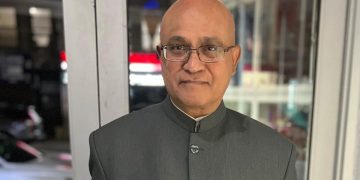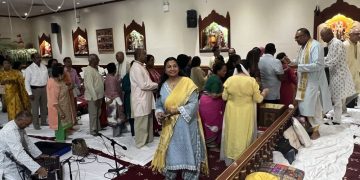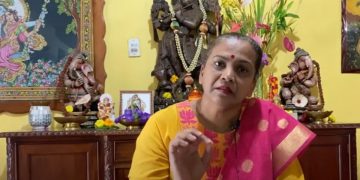Dear Editor,
Historical Background.
Historically, before foreign invaders came to India, Indian society evolved and structured the relations, between the Maharajahs, on the one hand; and Indian culture, music, dance, and the Hindu Mandirs/Temples, on the other hand, in a harmonious and beneficial way. The Maharajahs were responsible for providing assistance and protection for the Mandirs. This relationship allowed the Mandirs to become the center of activity in every village, town and city. The Mandirs were the heart beat of village and urban life.

Foreign Invaders.
With the coming of foreign invaders, the Mandirs lost their protection, and became the targets of destruction by foreigners. This destruction was necessary, in order to break Indians society and make it susceptible to foreign religious indoctrination. Once the destruction began, political, economic, and military domination followed. The Arabs, Persians, Turks, Afghans, and eventually, the Europeans, all contributed to the destruction of “all things” that contributed to the Hindu way of life.
A major feature of the destruction of the Hindu way of life was the conversion of our people. When the foreign Persian, Turk, European or Afghan converted our people, they got a natural ally to pursue their colonization of India. Foreign armies in India, and their government bureaucracy were largely made up of converted Indians and Rented Hindus. The converted Indians became the most dangerous weapons against Hindus. They were more dangerous than the mightiest guns of the enemy. At the end of British rule in India, there were more Indians in the British-Indian army, than Britishers. We must not forget Hindus, who rented out themselves to foreign occupants of India, are equally guilty of selling out their country. It is said the early Muslim invaders from Persia, Turkey, and Afghanistan destroyed over 60, 0000 Mandirs
British Administering of Mandirs; the Looting of Mandir Wealth.
The British, as they began to consolidate their power in India, realized that the Mandirs were the center of Hindu life, and most importantly, mandirs were a big source of revenues. In 1817, the British East India Company passed the Madras Resolution. Hindu Mandirs were brought under the administration of the British East India Company. Hindu Mandirs were the repositories of a great deal of wealth such as money and gold donated by devotees over the years. The East India Company began to loot the wealth of the mandirs.
In the 1840’s, Christian missionaries were afraid of a close relationship developing between the British administrators of the Mandirs, and their Hindu subjects; which they felt would negate ideas of Christianity supremacy. The missionaries protested, and demanded the Mandirs be returned to the Hindus. The missionaries felt that Christians should have nothing to do with non-Christian temples. Since the wealth was already looted by British authorities, the Mandirs were returned to the Hindus.
Religious Endowment Act and Mandir Land.
In 1863, the British authorities realized there was more wealth to be gained from the Hindu Mandirs. These Mandirs owned a great deal of land. Similarly, Mosques and Christian Churches owned vast land holdings in the Middle East, Europe and Latin America. At one time, the Catholic Church was the biggest land owner in Europe and South America. In their zeal to extract more wealth from the Mandirs, the British authorities passed the “Religious Endowment Act,” which gave the colonial authorities control over Mandir Land. A great deal of land was stolen from the Mandirs.
In 1925, the Mandirs became a center for rallying Hindu nationalists to fight against British colonialism. The British colonial authorities passed the Religious and Charitable Endowment Act to increase their control over the Mandirs. Historically, other religious groups were left alone. Hindus being 85 % of the population; the British authorities knew that a “Hindu Awakening” represented the greatest threat to their rule. While the other religious groups protested against interference in their religious centers, Hindu complacency easily accommodated British colonial interference in their Mandirs.
Since the Socialist Congress party and the Nehru family came into power after independence, they never dismantled the colonial institutions that suppressed the Hindu people, for example: the best education institutions were left in the hands of Christian schools; monuments to foreign monarchs such as Queen Victoria, Persian and Afghan rulers remained in prominent places in India; important landmarks such as Connaught Square are still named after foreigners; Higher education is controlled by Socialist professors, who prevent the teaching of Hindu pride and the Vedas; Jawaharlal Nehru University is a Socialist paradise of anti-Hindu activities; all these anti-Hindu activities takes place in the face of Hindu complacency.
Nehru Domestic Colonialism; Attacks on Hindus.
Now, why I am stating and re-stating these facts? We must remember, colonialism did not end when the British left India. Only foreign colonialism “ended.” A new virulent form of domestic colonialism began in India. This domestic colonialism was initiated by the Socialist Congress Party, Jawaharlal Nehru, and continued by his daughter Indira Khan (aka: Indira Gandhi). What does this domestic colonialism have to do with the destruction of the Hindu temples?
In 1951, the Nehru government, following British colonial policies, passed the Religious and Charitable Act to control the Mandirs. This act was struck down by Madras High Court and the Supreme Court of India. In 1959, there was the Tamil Nadu Religious and Charitable Act to control the Mandirs. In Kerala, the Chief Minister uses Mandir money for any purposes, except Hindu causes.
45,000 Mandirs under Government control, 12,000 Mandirs Physically Decaying.
After 70 years since Independence, the government of India has under its control 45,000 mandirs. There are now 12,000 mandirs that are physically decaying, from lack of maintenance. These Mandirs were once lively with many active members. Today, there are almost no devotees at these temples. According to Sadguru, these 12,000 mandirs are dying from a slow suffocation, because of government willful lack of adequate supervision and maintenance. Now, it is important to remember that only Hindu Mandirs are being supervised, no other religious groups have their centers of worship supervised by the government.
1975 State of Emergency and 1976 Secular Act.
In 1975, Prime Minister Indira Khan (aka: Indira Gandhi) had to resign over many issues: the court found her guilty of electoral mal-practices; she was accused of allowing widespread corruption in country; forced sterilization of Hindus; and Jaya Prakash Narayan led a campaign to force Indira Khan to resign. Before resigning, she declared a “State of Emergency” and arrested thousands. The majority of Hindu nationalists were leading the movement to force her to resign. Indira realized that she had lost many voters among the Hindu community. In 1976, she decided to solidify her Muslim base by passing a biased Secular Act, which would give Muslims many protections at the expense of the Hindus.
In 1976, the Secular law provides special rights for Muslim Men, while ignoring equal rights for Muslim women in matters of alimony and property inheritance. In other words, the Muslim Ulema, which are male dominated, can legitimize divorcing Muslim women without providing for alimony. These Ulema can also decide that Muslim women are denied equal inheritance in matters of property rights. This secular law of 1976 was primarily aimed at getting votes from the Muslim community. It is generally agreed that the Indian secular law is politically motivated, and not designed to bring about real secularism in society. In the Western World, where we got our modern concept of secularism; there is an absolute division between church and state. In the United States, separation of church and state means exactly what it says, separation of these two spheres- government from religion. In the U.S, the government doesn’t administer churches or religious institutions. The idea of the government interfering in the governing process of a religious body would be ridiculous.
Indira used the Emergency to stay in power for an additional 20 months. In 1977, Indira resigned, and declared new elections. A unity among the various Hindus nationalists joined and won a resounding victory in the elections. Moraji Desai was sworn in as the new Prime Minister. This was the first time the Congress Party lost a federal election for Prime Minister of India. This election showed that when Hindus get out of their complacency and unite, they could win elections.
Socialism and the Congress Party.
In India, the idea of government interfering in the management of Hindu Mandirs is great for the socialist Congress Party that wants to diminish and destroy Hinduism. Secularism is a great weapon to be used in the pursuance of Socialism. This is the reason why Sadguru says “12,000 government administered Mandirs” with a magnificent history and architecture, which reflects our great cultural history have been left to suffocate and die an unnatural death, while a complacent Hindu community ignores the damaging effects of the Indian government’s role in this destruction. A major problem is recognizing that the Congress governments, in the past, have pursued an anti-Hindu path. You have to remember that Socialism is an atheist philosophy; it considers Hinduism and Islam among the lowest level of religions, ranking alongside Voodoo and Animism.
Recognizing the Threat from the Socialists.
Another problem is recognizing the threat from the Socialists. In fact the majority of these socialists are from Hindu background with Hindu names, for example when someone with a name such as Singh comes to the Hindu community for votes, we think his name is Singh and he is a Hindu; therefore he can’t be a threat to us. Beware; the devil of destruction comes in many forms. We must get the government out of the Hindu religion in: India; Trinidad, where there is a movement to end religious schools such as those of the Maha Sabha and ASJA; the rest of the TRIGUSH area (TRIGUSH-Trinidad, Guyana, Surinam, and Hindu); and all countries. We must save the Hindu Mandirs in India and religious schools all over the world. If not, as Sadguru says we will suffocate and die a slow and unnatural death. Remember, “Freedom is not Free;” we have to constantly fight to maintain our freedom. The “Price of Freedom is Eternal Vigiliance.”
Jai Ram, Jai Shri Guru Ramesh “Rennie” Ramracha.
Founder and President of THE TRIGUSH (Trinidad, Guyana, Surinam, Hindus) ASSOCIATION;
Chairman of the TRIGUSH LIBRARY;
Mr. Ramracha was a lecturer at City University, N.Y;
Retired Teacher from the Dept of Ed, N.Y.C;
He holds a few graduate degrees from N.Y. area universities.









































































